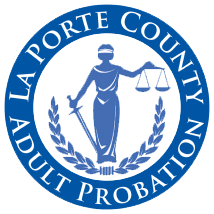Pre Trial Release


Stephen Eyrick,
Chief Probation Officer
Robert Schuster,
Deputy Chief Probation Officer –
La Porte Division
809 State Street Suite 101
La Porte, IN 46350
HOURS:
Monday through Friday:
8:00 AM – 4:00 PM
Lyn Swanson,
Deputy Chief Probation Officer – Michigan City Division
300 Washington St., Suite 337
Michigan City, IN 46360
HOURS:
Monday through Friday:
8:00 AM – 4:00 PM
Corissa Strader,
Drug Court Coordinator
809 State Street Suite 101
La Porte, IN 46350
Ashley Wright,
Pretrial Services Coordinator
809 State Street Suite 101
La Porte, IN 46350
On January 1, 2020, the Indiana Supreme Court enacted Criminal Rule 26, establishing pretrial services throughout Indiana. Over a process of nearly two years, a team of stakeholders met regulary, brought training from the National Instituts of Corrections to the County, attended trainings in several states and developed a pretrial process for LaPorte County. This team consisits of Judges, Probation Officers, Law Enforcement, Community Corrections, Mental Health, Minesterial Representative, County Clerk, County Auditor, County Council and County Commissioner.
The Pretrial Services Program operates within the Adult Probation Deparmtent and is responsible for:
- Interviewing all newly arrested persons
- Conducting a pretrial risk assessment
- Preparing background investigations on those individuals
- Producing bond reports for Arraignment Court daily
- Supervision and monitoring those individuals placed under supervision of the pretrial program
- Completing additional bond reports as ordered by the County Courts
The 3 M’s of Smart Pretrial
American law contemplates a presumption of release before trial. This notion underlies all aspects of a high functioning pretrial system. The United States criminal justice system was designed purposely to place limits on the power of government in its treatment of individuals accused of a crime. As the U.S. Supreme Court articulated in United States v. Salerno: “In our society, liberty is the norm, and detention prior to trial or without trial is the carefully limited exception.” Although the legal framework for pretrial decisionmaking favors release before trial, it also allows the government to impose conditions to reasonably assure public safety and court appearance while facilitating release—and under the extremely limited circumstances where no condition will guarantee either, outright detention.
For hundreds of years, courts imposed conditions of bail to motivate the accused to return to court. In 1951, the U.S. Supreme Court in Stack v. Boyle wrote that—in modern times— bail “serves as additional assurance of the presence of an accused,” continuing: “Bail set at a figure higher than an amount reasonably calculated to fulfill this purpose is ‘excessive’ under the Eighth Amendment.” In fact, until the 1970’s, court appearance was the sole justification for limiting pretrial freedom.
Providing for public safety is one of the underlying goals of both the pretrial justice system and the larger criminal justice system. Although public safety was not considered a proper reason to impose conditions until the 1970’s, today it is recognized as an underlying goal of effective systems. It is widely recognized that an individual’s potential impact on public safety should be assessed and considered in pretrial decision-making. In fact, the federal judicial system, along with at least 36 states, considers public or individual safety explicitly as part of the release or detention decision. Pretrial detention should be a “limited exception.” The Supreme Court has determined this exception may be authorized in cases where defendants are found “after an adversary hearing to pose a threat to the safety of individuals or to the community which no condition of release can dispel.”
